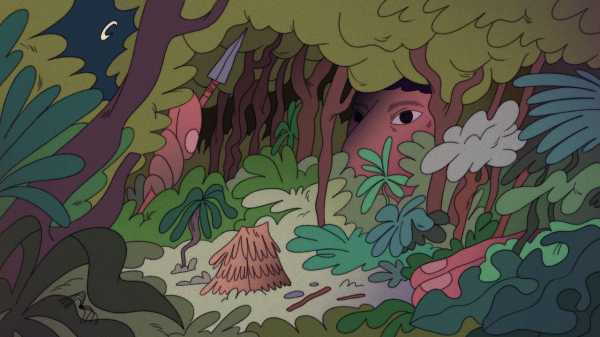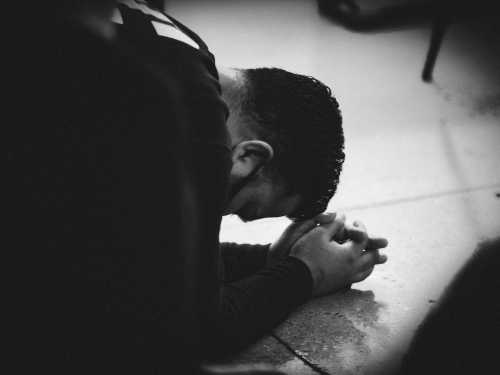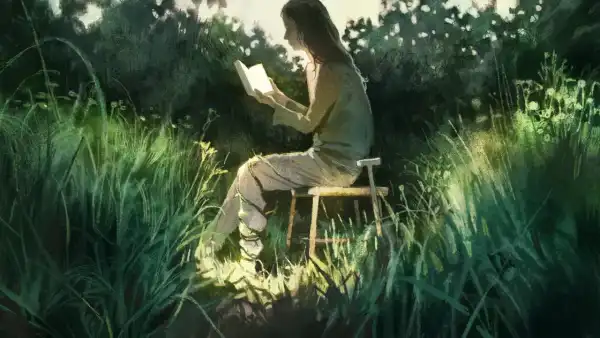
Not long ago, in the forest in the Brazilian state of Rondônia, a man who was around sixty years old settled into a handmade hammock inside his small thatched hut, stretched his legs, and died. His last breath, like almost every other moment of the previous twenty-six years of his life, was witnessed by no one. He was the last surviving member of an uncontacted Indigenous tribe.
The man’s story, or the fraction we know of it, began in 1996, when Brazilian officials heard rumors of a lone tribesman said to be on the run from loggers who were venturing ever deeper into the forest. During the next nine years, members of FUNAI—Brazil’s federal bureau of Indigenous affairs—launched a series of expeditions to try to peacefully contact him, and to protect him from the men who were rapidly clearing trees for cattle ranches and soybean farms. The lone man lived in small huts woven from thatch and palm fronds; as loggers inched closer, he’d abandon one hut and build a new one, deeper in the forest. Inside each of the structures, he always dug a rectangular hole about four-and-a-half feet deep, over which he often strung a firm hammock. Those pits inspired the name they gave him: “indio do buraco” or “the Indian of the hole.”
The attempts at peaceful contact failed. The first time a small team from FUNAI confronted him directly, the man retreated to his hut. For two hours, the team members tried to convince him that they were friendly. They offered gifts—seeds, a machete, corn. The whole time, he aimed an arrow at them through a hole in the wall of the hut, saying nothing, refusing to emerge. On two separate expeditions, the team brought along members of one of the closest neighboring tribes—the Kanoê, a group that itself had experienced its first prolonged contact with the outside world just a year before. But their attempts at communication went nowhere, and they concluded that the lone man likely spoke a different Indigenous language. The final attempt to make contact, in 2005, ended when the man shot a FUNAI member with an arrow in the chest; it missed his heart, but nicked his lung.
Marcelo dos Santos, a former FUNAI agent, led the first expeditions to try to make contact with the man. After those prolonged standoffs, dos Santos tried to convince the Brazilian government to abandon its efforts to force contact. In 1998, he addressed a letter to the Justice Ministry, which oversees FUNAI. “We feel embarrassed by our insistence in trying to contact him,” dos Santos wrote. “The face of the Indian—always sullen, anxious, worried and permanently silent—has made it clear to us that he wants to be left alone.”
Dos Santos believed that the government should protect the man by protecting his land. He proposed the creation of an Indigenous reserve of about thirty square miles, which would be declared off-limits to trespassing and development. For years, dos Santos and his colleagues waged a fierce bureaucratic battle to preserve the land. Local ranchers threatened their lives, and regional politicians worked to strip them of their jobs. But, in 2006, a Justice Ministry decree stated that the lone man, as “the only remnant of his culture and ethnic group,” could legally be considered “a people,” and therefore qualified for a protected reservation. The Tanaru Indigenous Territory, named for a nearby river and with a population of one, was officially demarcated.
FUNAI built a monitoring station on the edge of the man’s territory. The agents no longer tried to force contact, but they wanted to make their presence known, in case the man ever decided to initiate contact with them. At least once a year, they conducted a “proof of life” excursion into his territory, just to lay eyes on him, to make sure he was alive and well.
I first visited the monitoring station in 2006, shortly after it was established, as part of my reporting for “The Last of the Tribe,” a book that I published in 2010 about the man and the efforts to protect him. At the time, an official named Altair Algayer, who’d worked alongside dos Santos on the initial expeditions and who’d also fought to establish the reservation, supervised the area. During one of our early conversations, he explained to me that, deep down, he hoped that the man could continue to live free from contact with the modern world. He also nursed the contradictory hope that they might meet one day. This was a man that Algayer had spent years thinking about, fighting for, empathizing with. Maybe, eventually, this lone survivor might come to the conclusion that he could no longer make it on his own—that he needed assistance, needed to lean on someone else. Algayer dreamed of being there for him in his final days, to shoulder just a little bit of the load the man had carried completely alone for so many years. To ease his passing out of this life.
It wasn’t to be.
In the annals of human history, there are very few individuals, if any, known to have experienced the depths of solitude that the lone man endured. For at least twenty-six years, he spoke to no one. Other than those tense standoffs with the FUNAI agents, it’s believed that he had no contact with anyone else. We can’t know for sure, but it’s possible that he never laid eyes upon anyone besides the agents in all those years.
Perhaps the closest historical equivalent to his case is that of the Lone Woman of San Nicolas, a Native American woman spotted in 1853 by a group of otter hunters on an island off the coast of California. Eighteen years earlier, the rest of her tribe had been brought to the mainland by Catholic missionaries, but she had been left behind. Upon being “rescued,” she was moved into a Catholic mission and christened with the name Juana Maria. Seven weeks later, she developed dysentery and died. The details of her life and survival were never fully fleshed out.
We do have a fairly good idea how the indio do buraco spent his days, thanks to the expeditions of dos Santos and Algayer. On one journey, Algayer fell into a pit that had been camouflaged by leaves; he narrowly escaped being impaled by sharpened spikes that the lone man had embedded in its bottom, to kill wild game, like the tusked boars that are abundant in his territory. Near his abandoned huts, the FUNAI agents found cooking fires and traces of some of the animals—turtles, armadillo, caiman—that he’d eaten. In clearings where he’d lived for extended periods, they discovered patches of corn and manioc that he’d planted and cultivated. The forest where he lived is full of animals and fruit trees, and the weather is generally mild. But to survive there so long, in complete isolation, strikes me as almost miraculous.
Dos Santos and Algayar had made contact with the Kanoê and another tribe, the Akuntsu, in 1995, a few months before they began looking into rumors about the indio do buraco. Those tribes had been reduced to four and seven members, respectively; accompanied by Algayer, I was able to spend time with the survivors inside their protected reservations. The eldest member of the Akuntsu was the tribe’s shaman, a man named Konibu. His life in the forest was hard. Five years after first contact, a storm ripped through the reservation, and a tree fell on top of one of the huts, killing a fourteen-year-old girl and shattering Konibu’s femur. Following Konibu’s instructions, the other tribe members tried to treat his injuries with herbal medicines and compresses. After two days, they gave up and trekked through the forest to a FUNAI encampment, where team members were able to place a satellite call to Algayer. At 4 A.M., Algayer commenced the seven-hour journey from his home to the tribal village. He and four other people carried Konibu in a hammock for five hours through the forest to the FUNAI camp, and then drove five more hours to a hospital. It was Konibu’s first trip in a motorized vehicle, and his first time outside of the forest. Twelve pins were set in his leg. If he had lived alone, like the indio do buraco, he would have died from his injuries within days.
So many mortal threats lurked on the periphery of the lone man’s life—venomous snakes, stealthy jaguars, electric eels writhing in the bottoms of shallow ponds. Minor injuries waited to grow into lethal infections. But the most dangerous hazard was always other people. Brazil’s constitution, ratified in 1988, gave Indigenous tribes the legal right to land they have traditionally occupied; this protected a lot of land from development, but it also created a powerful incentive for would-be developers to chase away or kill any undocumented tribes. (FUNAI has estimated that there are more than a hundred isolated Indigenous groups living in the forests of Brazil, only twenty-eight of which have been definitively identified.) In the nineteen-eighties and nineties, clashes between tribes and ranchers soared in Rondônia, where thousands of square miles of rainforest were falling to logging each year. Landowners have been known to hire gunmen to go after any undocumented tribes who live on land they seek to acquire.
Konibu showed me a scar on his tricep—a bullet wound that bulged and glistened like a leech. Before dos Santos and Algayer had contacted the Akuntsu, Konibu and his fellow-members had been attacked by gunmen. “I’m alone now, with no brothers,” Konibu told Algayer and dos Santos, through a translator. “The white men killed all of my friends—pow, pow, pow!” Today, only three members of the Akuntsu remain; Konibu died of natural causes in 2016.
The lone man seems to have endured a similar history of violence. After consulting dated archival satellite images from Brazil’s space agency, dos Santos discovered that a small patch of land in the middle of the rainforest had been cleared just a couple of months before rumors first surfaced about an uncontacted man on the run. The FUNAI team travelled to that remote clearing, and under a mess of bulldozed tree stumps and brush they discovered the ruins of a tribal village. They uncovered the destroyed remnants of several longhouses, which had been arranged in a semi-circular formation near small fields of manioc and corn. Inside the longhouses, they found a series of rectangular holes, which were about four-and-a-half feet deep, and completely unique among the Indigenous groups of Brazil. A subsequent FUNAI investigation suggested that armed workers hired by a local landowning family had raided and destroyed the tribe’s small village. It is believed that the rest of the man’s group—perhaps four to six people—were killed during that raid, and that he alone survived and escaped.
When the courts declared the Tanaru territory off-limits, a newspaper in São Paulo pointed out that the area set aside for the man was similar in size to a nearby municipality that housed around six hundred thousand residents. A debate arose. Was it ethical to save that much land for one person, when more people might benefit from its development?
Over the years, the government of Brazil has seemed to contradict itself on such questions. Brazil’s military dictatorship, which ruled from 1964 to 1985, energetically promoted development in the Amazon; it launched road-building programs and encouraged people who lived in the country’s densely populated cities to spread out into the forest. The government offered land to anyone who agreed to clear it, promoting the region as “a land without men, for men without land.”
But that attitude began to change as development campaigns fuelled widespread deforestation. After the dictatorship ended, the elected officials of Brazil’s nascent democracy instituted numerous safeguards to protect large swaths of forest. Still, many of the laws proved impossible to enforce, and those opposed to the preservation movement insisted that efforts to protect Indigenous tribes and their land had gone too far. Census figures indicate that less than one per cent of Brazilians identify as Indigenous, but the country’s Indigenous territories make up nearly fourteen per cent of its total land area. Particularly at the local level, politicians railed against the Indigenous territories in the name of economic development. One outspoken opponent was Jair Bolsonaro, a former military officer and an admirer of the dictatorship, who was elected President in 2018. During a campaign stop, he promised, “If I become President, there won’t be one square centimetre of land designated for Indigenous reservations.” He’s been true to his word, and human-rights groups have reported that his contempt for preservation has led to anti-Indigenous violence in the Brazilian Amazon. According to the Indigenous Missionary Council, a nonprofit group, land invasions on Indigenous territories increased by a hundred and fifty per cent in the months after Bolsonaro was elected.
Each year, the agency’s proof-of-life visits revealed that the indio do buraco was alive and seemingly well. In 2018, an agent took a video of the man vigorously swinging an axe—likely one that had been offered to him as a gift during a contact attempt—and harvesting papaya. Now that the man has died, however, the fate of the land is uncertain. The protection decree for the territory remains active until October, 2025. But one Indigenous advocacy group in Brazil, the Observatory for the Human Rights of Isolated and Recent Contact Indigenous Peoples, has already launched a campaign to protect the land indefinitely. “The Tanaru Indigenous Territory must remain preserved as a memorial, out of respect for the path of resistance taken by its lone resident, and to remind everyone of the tragedy of indigenous genocide—so that it never happens again,” the organization has written.
It was on FUNAI’s last proof-of-life visit, on August 23rd, that an agent approached the man’s hut, saw no signs of activity, and entered. The ashes of two extinguished fires were on the ground, next to the hole. The man was stretched out on the hammock, and his body appeared to be partially decomposed. An autopsy was planned, and DNA samples were to be collected from his remains; after the autopsy, his body will be returned to the Tanaru territory for burial. It’s possible that the autopsy, along with an investigation of his most recent dwelling, will reveal new information about his ethnicity, and perhaps shed new light on his way of life. But it won’t solve what I believe will always be the central mystery at the core of his story. What was going through his mind during all those years? How did he cope with the tragedy that shaped the second half of his life?
When I wrote “The Last of the Tribe,” I spoke about these questions with several psychologists. They speculated that it might be helpful to think not about how isolated he was but about how isolated he felt. Studies of people who’ve undergone extreme isolation suggest that their minds quickly begin holding conversations with imagined people and religious deities. “The mind is a terrific device, and it can generate other people in our environment, even if other people don’t actually exist there,” Nicholas Epley, a social psychologist at the University of Chicago, told me. “You can be alone in the woods, all by yourself, but still feel very connected if you are deeply religious, for example. You feel like there’s another agent there with you. In the same way, you can be married for forty years and feel totally alone.”
Despite the man’s clear reluctance to make friends with outsiders, the FUNAI team doesn’t necessarily believe that he was an embittered misanthrope. During one expedition, a team member named Paulo Pereira visited the man’s hut and found it unoccupied. Pereira observed the man’s bows and arrows, which were still in the hut, left the man some gifts, and then began to walk away through the forest. Suddenly, he heard a voice: “Ho!”
Pereira turned and saw the man standing among the trees, about fifteen yards away. Then he disappeared, vanishing into the foliage. Pereira, stunned, looked down and realized that he was standing at the lip of a spiked-bottom pitfall. It was the same kind of pit that Algayer had fallen into years before. Algayer had been saved by his bulky backpack, which snagged on the edge of the pit and prevented him from falling all the way down onto the spikes. Pereira wasn’t wearing a pack. By warning him of the danger, the man had likely saved him from serious injury or death.
Those moments of human connection were extremely rare, of course. Still, the agents tasked with protecting the man and his land grew to imagine him as a sympathetic, if extremely introverted, presence in the forest. Algayer and dos Santos believe that he likely observed religious rituals, as all of the other tribes of the region do; they have speculated that the holes he dug inside his huts might have served a symbolic purpose—digging them could have been a ritual for his tribe, with spiritual significance. When dos Santos, who is now retired from FUNAI, saw photos of the man’s body in the hammock, he noticed that it was covered with feathers. Perhaps, dos Santos speculated, the man had known he was ill, and had performed a ritual for himself as he lay down to die—a ceremony to mark the extinction of a tribe, a language, and a culture that history never named. ♦
Sourse: newyorker.com






